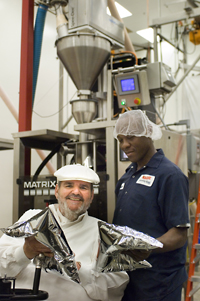
To meet the increasing demand for its products, Magic Seasoning Blends recently consolidated its two separate manufacturing and warehouse operations into one 125,000-sq.-ft. blending, packaging and warehouse facility. The company stocks 800 to 1,000 different spice ingredients, acquired direct from growers and distributors in various parts of the world. The ingredients are received by pallet loads of 50-pound boxes or 1,000-pound super sacks, coming from specific lot numbers in the growing fields to ensure uniform taste.
The plant environment is climate controlled to maintain consistent air temperature and humidity for the entire process of receiving, storing, blending and packaging. This minimizes product caking and streamlines throughput.
When a blend is released for production, ingredients are moved from the raw products warehouse to the plant’s blending area where they are placed into mixers located beneath loading stations equipped to handle up to 1,000-pound super sacks. Multiple horizontal double-ribbon blenders of various sizes make it possible to blend seasoning batches from 100 to 10,000 pounds; a typical batch is either 2,500 or 5,000 pounds.
After blending, the formulations are discharged into intermediate bulk containers (IBCs), capable of holding 2,500 pounds per sack. Then they are put into a climate-controlled warehouse until ready for packaging.
When an order is initiated for packaging, the selected IBCs are pulled from the warehouse and delivered to the automatic filler/unloader that feeds the filling machine designated for the run. The new plant has seven packaging lines:
- Bottling line for glass or plastic-Typical bottle size filled is 2 to 8 ounces for supermarket shelves and 24-ounce plastic jars for institutional use and restaurants. The system fills, caps and labels at the rate of 100 bottles per minute.
- Canning line-Used primarily for filling 8- to 16-ounce fiberboard canisters for retail sales, at the rate of 125 canisters per minute; it also fills 24-ounce canisters for foodservice and restaurants at 55 units per minute.
- Bag-in-box line-This line fills up to a 50-pound bag inserted into a box for institutional use and restaurants.
- Three flexible bag lines-Two horizontal form-fill-seal systems handle bag content sizes from 0.10 to 3.5 ounces; a vertical form-fill-seal line handles bags ranging in size from 4 ounces to 6 pounds.
- Cartoning line-Once packaged and labeled, the products pass through a cartoning line where they are automatically filled into boxes, sealed and labeled. A pick-and-place robot picks up and palletizes the boxes.
The pallets are stretched wrapped, then put into a climate-controlled warehouse or loaded into trailers for shipping.
“Twenty-five years ago, we were packaging everything by hand, screwing caps on by hand, labeling by hand, filling boxes by hand.” says David Hickey, vice president of manufacturing for Magic Seasoning Blends. “Now we are highly automated, and that has helped to bring an even higher level of consistency to our product line.”
To help maintain quality control, the entire facility is access-control secured. “Door card readers tie in with a comprehensive camera system to allow only authorized personnel into the facility,” Hickey explains, But we also use the camera system to keep our distributors and food processing clients informed about the location of their orders in the production, packaging and shipping process. Our co-packing clients, for example, can log onto our website and actually see their products in production.”
Despite the benefits of technology, Magic Seasoning Blends has not lost sight of it hands-on legacy. Since the day the company was formed, Chef Paul has been intimately involved in every aspect of its running.
“There is absolutely no end to developing herbs and spices,” says Chef Paul. “And my real passion is to make something that is healthy and exciting for our customers.”
For more information on Chef Paul Prudhomme’s Magic Seasoning Blends, Inc., contact John L. McBride, 504-732-3590; jlm@chefpaul.com or visit the website.
